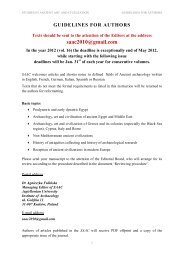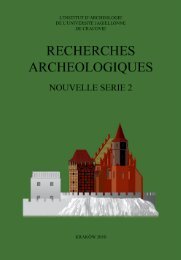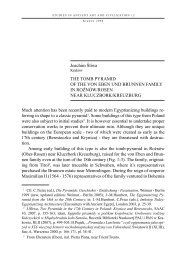l'institut d'archeologie de l'universite jagellonne de cracovie ...
l'institut d'archeologie de l'universite jagellonne de cracovie ...
l'institut d'archeologie de l'universite jagellonne de cracovie ...
Create successful ePaper yourself
Turn your PDF publications into a flip-book with our unique Google optimized e-Paper software.
Excavations of the Western Kom at Tell el-Farkha in 2006<br />
each (Dreyer 1986, 103, inv. no. El.K. 1444,<br />
1022, 1009). Statues of mothers with children<br />
are also kept in London (B.M. 32143)<br />
and in Berlin (14.441), however we do not<br />
know where they come from. In the first<br />
case a woman in a long robe holds in her left<br />
hand a child that hangs on her back, in the<br />
second one a naked woman holds a child on<br />
her hip (Capart 1905, 168f.). In this context,<br />
the figurine from Tell el-Farkha presenting<br />
a standing woman with a child on her hand<br />
(no. I.A-4) is nothing extraoriginal, thought<br />
it shows another approach to the theme. A<br />
different view, however, is required when<br />
discussing the representation of a woman<br />
with a child on her knees sitting in an oval<br />
object similar to a basket that is probably a<br />
kind of a litter (I.A-5). In the case attention<br />
should be drawn on some representations in<br />
relief and small objects of plastic art. The<br />
former show figures in litters and the most<br />
popular are the maceheads of Scorpion and<br />
Narmer (Ciałowicz 2001, 197 ff.). There are<br />
covered litters known from sculpture, sometimes<br />
comprising a figure (Belova, Sherkova<br />
2002, fig. 49; Schlögl 1978, 26f.). These<br />
objects may suggest that the representation<br />
from Tell el-Farkha can be in relation<br />
to reput, recognized as a representation of<br />
a mother, a divine pharaoh’s mother (Kaiser<br />
1983, 262) or in a broa<strong>de</strong>r sense women<br />
from the royal family (Millet 1990, 58).<br />
The treading man from Tell el-Farkha<br />
(I.B-2) was probably wearing only a penissheath<br />
(unpreserved). Similar, though not<br />
i<strong>de</strong>ntical figurines are registered in the period<br />
of Naqada I. Most of them – i.e. the famous<br />
figure of Mahasna (Ayrton, Loat 1911, XI,1)<br />
– kept their legs together and their hands<br />
were falling along the bodies. It draws attention<br />
that their ears were marked without<br />
exaggeration. Similarly some other figurines<br />
from Hierakonpolis were shown (Quibell,<br />
Petrie 1900: pl. VII). Analogous can be also<br />
a partially preserved faience figurine from<br />
441<br />
Elephantine (Dreyer 1986, 99; inv. no. El.K.<br />
747). Like ours it shows the arrangement of<br />
arms: the right bent obliquely lays on the<br />
chest (in our figurine it is the left arm); the<br />
left one is broken off but was falling along<br />
the body. The figure’s hair are short and expose<br />
relatively large ears. The face just like<br />
in our figurine is quite round and the mouth<br />
are wi<strong>de</strong> and slightly smiling.<br />
The enveloped in a coat man from Tell<br />
el-Farkha (I.B-1) has no its direct counterpart.<br />
In a very similar way, a coat covers<br />
also a famous figurine from Abydos (British<br />
Museum 37 996; Petrie 1903, 24, pl. II:3).<br />
Although, it is badly damaged, it seems<br />
that in this case, too, one hand was showing<br />
from un<strong>de</strong>r the coat’s folds. What draws attention<br />
is the very <strong>de</strong>corative structure of the<br />
coat. I<strong>de</strong>ntification of the represented figure<br />
facilitates the Upperegyptian crown on his<br />
head – doubtlessly the sculpture from Abydos<br />
showed one of the early rulers during his<br />
sed jubilee. In the case of the figure from Tell<br />
el-Farkha we are not absolutely sure, though<br />
the representation of a figure in a <strong>de</strong>corated<br />
coat is significant. In the early Egyptian art<br />
it is reserved for rulers, enough to mention<br />
statues of Ninecher, Chasechem or Djoser.<br />
In the former from beneath the coat’s fold<br />
hands come out that hold the royal insignia<br />
(Simpson 1956). In the figurine from Tell el-<br />
Farkha’s hand could have been a presently<br />
missing heka-scepter. Lack of crown on the<br />
head that would <strong>de</strong>finitively allow to recognize<br />
him as a ruler’s representation is not<br />
final, either. On the heb-sed representations<br />
Niuserre led the procession dressed only in<br />
an apron and a headscarf (Kaiser 1971, 94).<br />
In our case the situation is not i<strong>de</strong>ntical, but<br />
it allows to think that in the early period a<br />
ruler could have been shown without his<br />
crown. So it may be assumed that the man<br />
in the coat from Tell el-Farkha could have<br />
represented an anonymous ruler during his<br />
sed jubilee.





